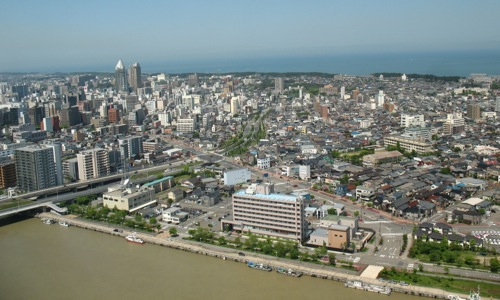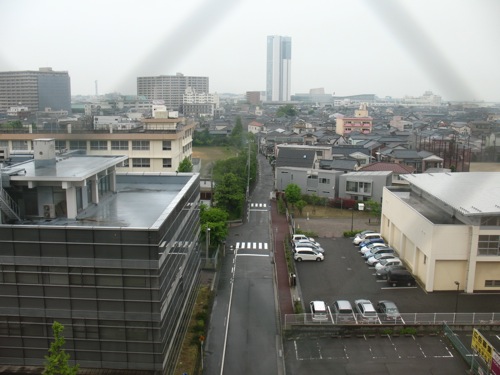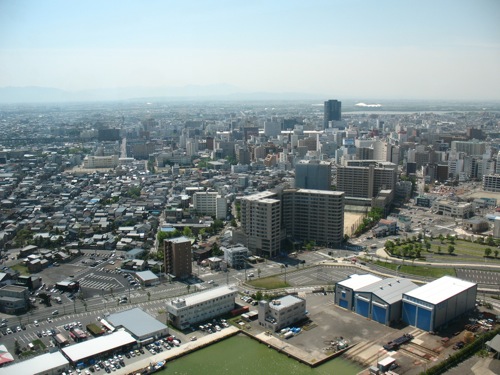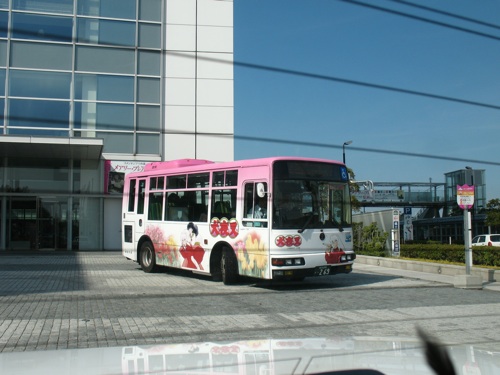Niigata City, capital of Niigata Prefecture, isn’t really a travel destination for foreign tourists at all, but we ended up staying there for five nights because of a conference Yan was attending. Unsurprisingly, there was a huge contrast with Kyoto in terms of Romanized signage, though there were two English-language maps at the tourist information center (one, of restaurants, was somewhat out of date).

When researching this trip, it seemed that all the guidebooks basically assumed one would just use the city as a jumping-off point to ferries to Sado-ga-Shima, the island just off the coast. So I did a lot of scrounging online for information about things to do, some of which came in handy. I thought I’d put that info here for others to reference.
The bus system worked pretty similarly to the one in Kyoto (pay at front when exiting), so that made it a bit easier, but we ended up mostly walking (which was pretty doable). There were no paper maps of the bus system available at the tourist office, but the main terminal, on the north end of the train station, has a large mural that depicts the city but routes (unfortunately, we didn’t discover this until the day before we left).

The place where our lack of ability to read Kanji was most of an issue was in restaurants. It’s much harder to be more adventurous about that sort of thing when one is a vegetarian. So we didn’t eat as well as we did in Kyoto. …I should probably rephrase that to say we did have some good food (some really excellent tofu one night, and some damn good sushi), but the language barrier created challenges.
The city is definitely grittier than Kyoto. It didn’t help that it rained off and on most of the time we were there- it sort of added to the industrial landscape. We stayed in an inexpensive business hotel, Dormy Inn, which was close to the train station and a bit over a kilometer from Yan’s meeting site. It was quite nice for the price- had an en-suite bathroom (it was also larger than the Kyoto hostel!) and two onsen on the premises (which we didn’t avail ourselves of).

There are a few main areas of tourist interest in the city. Downtown/Bandai (between the train station and the Shinano River) contains a lot of restaurants, shopping, bars, and strip clubs. Across the Shinano River to the north is the more traditional nightlife district (possibly more upscale bars?) and what seemed to be a newer downtown area. This more northerly district historically had lots of canals; it was a port area as well as the red-light district. Today, the canals have been filled in and are now streets. It’s fairly easy to walk between and around these areas. South of the station (which we didn’t get to ) is the main pro soccer stadium and a large lagoon with parks and gardens. Much of the rest of the city is residential and industrial areas.

I’ll post later about two areas in the city where I took walks: along the Shinano River to Hakusan Park, and to Nishikaigan Park along the coast.
I ended up doing three day trips out of the city using my rail pass (Tokyo’s Ueno Park, Echigo-Yuzawa, and Fukushimagata Wetlands); I could probably have spent another day just wandering the city instead, but these were things I was pretty excited about seeing (more in later posts).
Things I ended up not seeing that seemed like they might be neat:
- Northern Culture Museum (via bus): an old family estate and teahouse in a rice-growing area.
- Sakata & Murikami (via train): small towns with historic areas that were recommended to me as scenic.
- Yahiko (via train): a forested mountain and shrine southwest of the city.
- Toyanogata Lagoon (via bus): Big Swan Stadium is on this lagoon; there are also parks and apparently excellent birding in winter.
- Sado Island, of course.
- There’s also a tourist but that takes a route through scenic parts of the city, which would have been useful for orientation, but I didn’t take:

3 replies on “Venturing to Niigata”
[…] of my day trips out of Niigata was to the Fukushimagata wetlands for birding. Fukushimagata is a park a bit northeast of Niigata […]
[…] one of the days we were in Niigata, I took the train to Echigo-Yuzawa, an onsen/ski resort town, to sightsee and try some birding. […]
[…] the most unexpected thing I saw on my walk-even odder than the Befco crackers or the Inu-Yasha bus-I spotted in a shopping center hallway while looking for a place to grab lunch. It was a sort-of […]